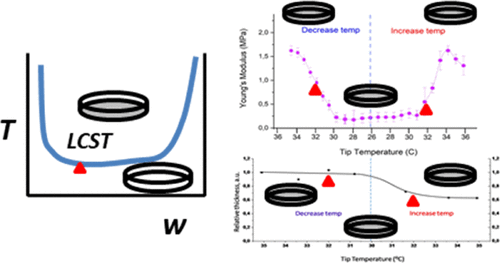Our official English website, www.x-mol.net, welcomes your feedback! (Note: you will need to create a separate account there.)
Thin Thermoresponsive Polymer Films for Cell Culture: Elucidating an Unexpected Thermal Phase Behavior by Atomic Force Microscopy
Langmuir ( IF 3.9 ) Pub Date : 2021-09-17 , DOI: 10.1021/acs.langmuir.1c02003 Anastasia Frolova 1, 2 , Evgenii Ksendzov 3, 4 , Sergei Kostjuk 1, 3, 4 , Yuri Efremov 1, 2 , Anna Solovieva 5 , Yuri Rochev 1, 6 , Peter Timashev 1, 2, 5, 7 , Svetlana Kotova 1, 5
Langmuir ( IF 3.9 ) Pub Date : 2021-09-17 , DOI: 10.1021/acs.langmuir.1c02003 Anastasia Frolova 1, 2 , Evgenii Ksendzov 3, 4 , Sergei Kostjuk 1, 3, 4 , Yuri Efremov 1, 2 , Anna Solovieva 5 , Yuri Rochev 1, 6 , Peter Timashev 1, 2, 5, 7 , Svetlana Kotova 1, 5
Affiliation

|
Application of poly-N-isopropylacrylamide (PNIPAM) and its more hydrophobic copolymers with N-tert-butylacrylamide (NtBA) as supports for cell sheets has been validated in numerous studies. The binary systems of these polymers with water are characterized by a lower critical solution temperature (LCST) in a physiologically favorable region. Upon lowering the temperature below the LCST, PNIPAM chains undergo a globule-to-coil transition, causing the film dissolution and cell sheet detachment. The character of the PNIPAM–water miscibility behavior is rather complex and not completely understood. Here, we applied atomic force microscopy to track the phase transition in thin films of linear thermoresponsive (co)polymers (PNIPAM and PNIPAM-co-NtBA) prepared by spin-coating. We studied the films’ Young’s modulus, roughness, and thickness in air and in distilled water in a full thermal cycle. In dry films, in the absence of water, all the measured parameters remained invariant. The swollen films in water above the LCST were softer by 2–3 orders of magnitude and about 10 times rougher than the corresponding dry films. Upon lowering the temperature to the LCST, the films passed through the phase transition observed as a drastic drop of Young’s modulus (about an order of magnitude) and decrease in roughness in both polymers in a narrow temperature range. However, the films did not lose their integrity and demonstrated almost fully reversible changes in the mechanical properties and roughness. The thermal dependence of the films’ thickness confirmed that they dissolved only partially and required an external force to induce the complete destruction. The reversible thermal behavior which is generally not expected from non-cross-linked polymers is a key finding, especially with respect to their practical application in cell culture. Both the thermodynamic and kinetic factors, as well as the confinement effect, may be responsible for this peculiar film robustness, which requires overcooling and the aid of an external force to destroy the film.
中文翻译:

用于细胞培养的热敏聚合物薄膜:通过原子力显微镜阐明意外的热相行为
聚的应用Ñ -isopropylacrylamide(PNIPAM)及其与更疏水共聚物ñ -叔-butylacrylamide(NTBA)作为细胞片支撑件已在许多研究中得到验证。这些聚合物与水的二元系统的特点是在生理上有利的区域具有较低的临界溶解温度 (LCST)。在将温度降低到 LCST 以下时,PNIPAM 链会发生小球到线圈的转变,导致薄膜溶解和细胞片分离。PNIPAM-水混溶行为的特征相当复杂,尚未完全了解。在这里,我们采用原子力显微镜来追踪线性热响应的(共)聚合物(PNIPAM和PNIPAM-的薄膜的相变共-NtBA) 通过旋涂制备。我们在完整的热循环中研究了薄膜在空气和蒸馏水中的杨氏模量、粗糙度和厚度。在干膜中,在没有水的情况下,所有测量参数保持不变。LCST 以上的水中溶胀膜比相应的干膜柔软 2-3 个数量级,粗糙约 10 倍。在将温度降低到 LCST 后,薄膜通过相变,观察到杨氏模量急剧下降(大约一个数量级),并且在狭窄的温度范围内两种聚合物的粗糙度降低。然而,薄膜并没有失去它们的完整性,并且在机械性能和粗糙度方面表现出几乎完全可逆的变化。薄膜厚度的热依赖性证实它们仅部分溶解并且需要外力来引起完全破坏。非交联聚合物通常无法预期的可逆热行为是一个关键发现,尤其是在它们在细胞培养中的实际应用方面。热力学和动力学因素以及限制效应可能是造成这种特殊薄膜坚固性的原因,这需要过冷和外力的帮助来破坏薄膜。
更新日期:2021-09-28
中文翻译:

用于细胞培养的热敏聚合物薄膜:通过原子力显微镜阐明意外的热相行为
聚的应用Ñ -isopropylacrylamide(PNIPAM)及其与更疏水共聚物ñ -叔-butylacrylamide(NTBA)作为细胞片支撑件已在许多研究中得到验证。这些聚合物与水的二元系统的特点是在生理上有利的区域具有较低的临界溶解温度 (LCST)。在将温度降低到 LCST 以下时,PNIPAM 链会发生小球到线圈的转变,导致薄膜溶解和细胞片分离。PNIPAM-水混溶行为的特征相当复杂,尚未完全了解。在这里,我们采用原子力显微镜来追踪线性热响应的(共)聚合物(PNIPAM和PNIPAM-的薄膜的相变共-NtBA) 通过旋涂制备。我们在完整的热循环中研究了薄膜在空气和蒸馏水中的杨氏模量、粗糙度和厚度。在干膜中,在没有水的情况下,所有测量参数保持不变。LCST 以上的水中溶胀膜比相应的干膜柔软 2-3 个数量级,粗糙约 10 倍。在将温度降低到 LCST 后,薄膜通过相变,观察到杨氏模量急剧下降(大约一个数量级),并且在狭窄的温度范围内两种聚合物的粗糙度降低。然而,薄膜并没有失去它们的完整性,并且在机械性能和粗糙度方面表现出几乎完全可逆的变化。薄膜厚度的热依赖性证实它们仅部分溶解并且需要外力来引起完全破坏。非交联聚合物通常无法预期的可逆热行为是一个关键发现,尤其是在它们在细胞培养中的实际应用方面。热力学和动力学因素以及限制效应可能是造成这种特殊薄膜坚固性的原因,这需要过冷和外力的帮助来破坏薄膜。



























 京公网安备 11010802027423号
京公网安备 11010802027423号